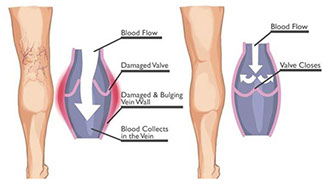

In a field often flooded with non-experts and marginal techniques, the Advanced Vein Care Center stands out and stands tall, setting the standard of excellence for vascular care in the region.

VEIN DISEASE
Venous disease is defined as the impairment of blood flow towards your heart. Understanding venous disease means understanding the complex system of veins that make up our legs.
Our legs are comprised of a network of veins that are similar to branches on a tree: they contain large, or major veins and increasingly smaller veins. Oxygenated blood is constantly being pumped from the heart to the rest of our bodies through arteries. It is the job of our veins to carry deoxygenated blood back to the heart.
Healthy veins have valves which open and close to assist the return of blood to the heart. Venous disease (also called vein insufficiency or venous reflux), occurs if these valves become damaged, allowing the backward flow of blood in the legs. Because gravity works on the legs more than on other parts of the body, these vein walls are under tremendous pressure. When blood cannot be properly returned through the vein, it can pool, leading to a feeling of heaviness and fatigue, causing varicose veins and other skin changes.
Approximately half of the U.S. population has venous disease.
Venous disease is a progressive disease that is not curable.
For most people, even debilitating symptoms are completely treatable.
Proper treatment means evaluating your complete venous system.
Stages of Vein Disease

Symptoms of Venous Disease
Spider Veins
Spider vein is the common term for blue or purple-colored veins that occur under the skin but are close enough to be seen on the surface. Spider veins can cause physical discomfort, but because of their appearance, they can be a source of embarrassment and self-consciousness, especially during the summer season.
Varicose Veins
Varicose veins are visible veins in the leg that bulge, often protruding through the skin. They are the result of venous insufficiency: blood that pools in the vein because of a faulty valve and causes the protrusion. Varicose veins are a symptom of early stage venous disease. medical help.
Swelling
While symptoms of early stage venous disease are not always painful, it is common to experience discomfort as the disease progresses. This can manifest through fatigue or general discomfort that gets worse over the course of a day or after standing for long periods, and can often be relieved by elevating the legs.
Skin Changes
Skin changes can occur during many stages of venous disease. Swelling may occur around the leg, ankles, or around the knees. Brown discoloration that appears as a stain on the skin is a sign of an advanced stage of venous disease. This occurs as a result of blood leaking from the blood vessels and into the skin tissue. This staining can lead to white spots and are a precursor to an ulcer.
Ulcers
Venous stasis ulcers in the leg are often an indication that venous disease has reached an advanced stage. Because venous disease is progressive, venous reflux can often lead to additional valve failure. As a result, the pooling of blood can affect a larger area. When blood pools in the lower leg over a long period of time, the condition is referred to as venous stasis.



Other Complications
of the Venous System
Superficial Thrombophlebitis
Superficial Venous Thrombophlebitis (SVT) is the term used for blood that becomes turbulent and pools near the surface of the skin, resulting in a clot in a superficial vein. Superficial refers to the veins just below the skin’s surface. Blood clotting and swelling in superficial veins rarely cause serious problems, but they can be extremely painful and lead to weeks of incapacitation while the leg heals. Frequent clots require treatment to fix the underlying venous insufficiency.
Deep Vein Thrombosis
Clots that occur in the deep vein system are called Deep Vein Thrombosis (DVT). This is a serious, life-threatening condition that requires immediate medical care. A clot in a deep vein can move through the bloodstream resulting in embolism.
BOOK NOW
813.876.7600
1921 W. Dr. Martin Luther King Jr. Blvd.
Tampa FL, 33607
At Advanced Vein Care, you receive one-on-one attention from professionals renowned for their expertise in the treatment of venous disease and cosmetic concerns. We invite you to learn more about our clinic and staff during your consultation visit!
Read More
ABOUT US
GET IN TOUCH
©2017. A sTANLEY R. DENNISON JR, MD COMPANY. All Rights Reserved